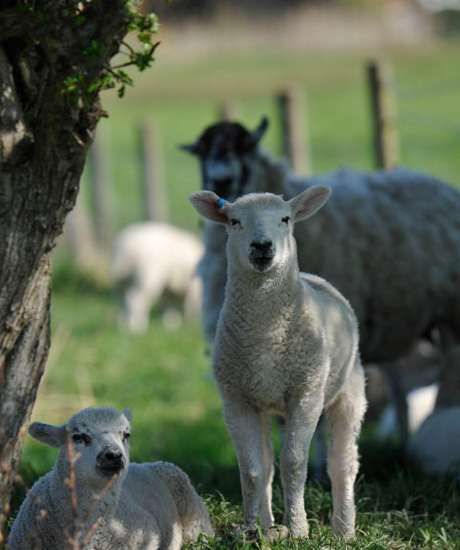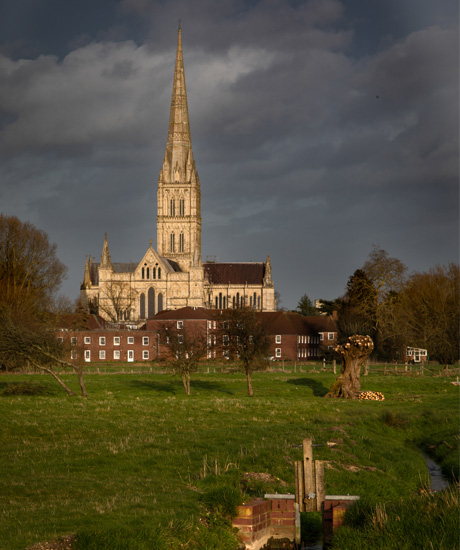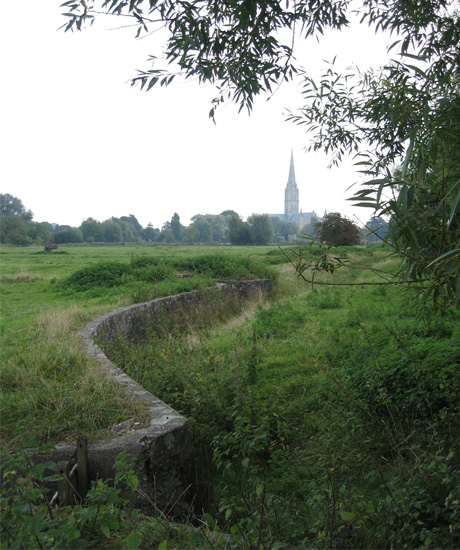The history of the
Harnham Water Meadows
Explore our History
The Harnham Water Meadows are one of England’s best-known meadow irrigation systems. Wessex, in general, is a critical area for water meadows.
They form an important part of the historical landscape along with canals, mills, watercress beds and other engineered river-system features.

More about the Harnham Water Meadows
Located between West Harnham and Salisbury, the meadows sit at the confluence of the River Avon and the River Nadder. This includes around 100 acres of historic bedwork water meadows in various states of preservation on an island in the river system. The Trust owns approximatey half of these, but manages all of them. Around 10 acres are irrigated most winters when river levels are sufficient. Some areas have lost their infrastructure and operate merely as flood meadows.
There were water mills at Fisherton for corn milling, and the West Harnham Old Mill was industrial. Originally river levels were controlled at both mills, making drowning of the meadows easier than today. Today’s automated radial sluice gates by The Old Mill pub replaced an original structure.
What is a water meadow?
A true water meadow is a pasture irrigation system watered at the discretion of the farmer and a skilled specialist worker. The person who maintained and operated the meadows was called the ‘drowner’.
What are bedwork water meadows and how do they work?
The form of water meadows at Harnham is called a bedwork. Water is diverted from the river at a main hatch and flows into channels called carriers. The water runs along the tops of the constructed ridges so that it trickles through the grass, ideally at a depth of 25mm.
The water returns via a series of drain channels that flow into a tail drain which, in turn, flows back to the river. The job of the drowner is to maintain an even flow, with irrigation events typically lasting between three days and one week.
‘Floated’ water meadows are used for irrigation in the winter or early in spring to warm the grass sward and pull nutrients and oxygen into the soil. Typically, this caused the grass to grow about one month earlier than un-floated floodplain meadows so livestock could benefit from an ‘early bite’ of grass.
During the summer months, when the soil was drying out, water meadows were re-watered and could then produce two hay crops when ordinary floodplain meadows typically produced only one crop. This was very valuable at a time when transport was by horse or oxen, as well as for the cattle and sheep produced for food and wool.
What is a floated water meadow?
Floated water meadows were man-made, almost level fields, built in broad river valleys. They required careful construction to ensure they worked properly and were managed by skilled workers, called drowners. The aim of a floated water meadow was to manage irrigation of the fields in winter or early spring. It would help to warm the grass sward and pull nutrients and oxygen into the soil. This meant the grass would grow earlier than it normally would, providing extra grazing for lifestock, before the growing season was in full flow.
The early history of water meadows
Historically water meadows proved to be very important economically. Their construction and operation can be shown to date from the middle-ages in both England and continental Europe, but their widespread adoption really occurred during the seventeenth century.
Floated water meadows spread throughout Wessex, starting in Dorset in the 1600s and reaching the Wiltshire chalk valleys by the 1630s. There is no clear documented information describing the construction of the Harnham Water Meadows. However, on circumstantial evidence, it is believed to have been around 1660. This was when the meadow system was laid out on a pre-existing marshland at the confluence of the Avon and Nadder.
17th and 18th Century
Water Meadows
In the seventeenth and early eighteenth centuries, sheep were led away from the meadow in the afternoon into fields of wheat or barley. Their dung and urine would fertilise the arable land on the valley sides where they were ‘folded’ overnight.
The system’s economic stimulus was corn price rather than sheep products, although these were a necessary by-product, and the wool would have been used to manufacture textiles in Salisbury. This Sheep-Corn system was of great importance during the period of the French Revolution and Napoleonic Wars, when the country had to be as self-sufficient in food as possible. It is thought the hay crop was essential at Harnham because it would have supplied coaching inns in the City.
A detailed enclosure map of West Harnham dates from 1787. It shows the two mills and meadow names suggesting a fragmented ownership pattern. The shape of the river channels is also remarkably similar to the modern day, pointing to channel stability around the island upon which the meadows are located. This suggests there would have been an effort to maintain the status quo because of the functioning mills and fields around Fisherton and West Harnham.
While talking about the 19th century water meadows, readers may recognise them from John Constable’s famous 1831 painting, ‘Salisbury Cathedral from the Meadows’. It is probably the most famous painting of the cathedral.
Changes in agriculture affect the water meadows
The vulnerability of the Sheep-Corn system to the economic downturn and technological change was demonstrated by factors such as labour costs, the introduction of imported fertiliser, and cheaper production of grain and lamb from North America and Australasia. This primarily occurred after the recession in English agriculture in 1879. After this time, some water meadows would have been abandoned while others changed to alternative husbandry depending on market prices for milk, meat, and hay.
Mid-19th century water meadows
to modern times
In the mid-19th century, the Earl of Pembroke made the last significant changes to the Harnham Water Meadows. His team built new carriers, hatches and aqueducts, formed using Victorian concrete, and small bridges over the channels to enable hay carts to be used to transport the hay off the meadows. The recession after 1879 meant that between 1880 and 1950, the number of sheep in Wiltshire dropped. Artificial fertilisers were introduced for arable land, farming was mechanised and many water meadows were gradually abandoned.
At Harnham, only the lower Seven Acres would likely have been watered throughout the history of the meadows. Here, land sales, removal of hatches and possible shallow ploughing in some areas during the Second World War diminished the infrastructure designed to irrigate the meadows. While anecdotal evidence suggests watering in places continued until the 1950s, installing the radial gates at West Harnham in the 1970s caused the overall river level to drop. Over-abstraction upstream further reduced the volume of river water available for irrigation.
Protecting the water meadows
In 1990 the Harnham Water Meadows Trust was formed to restore and preserve this internationally important heritage site and, where possible, increase the irrigated area of the historic water meadow.
Our aim, as a Trust, is to protect and preserve this delicate and unique environment for generations to come. We are a small, local charity run solely by volunteers and we are always looking for both extra help, and financial supporters.







